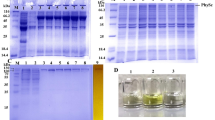Abstract
Glyoxalase I is a ubiquitous enzyme that detoxifies methylglyoxal, which is derived from glycolysis but inhibits the growth of cells from microorganisms to mammals. Here, the structural gene for glyoxalase I (glo1 +) from the fission yeast Schizosaccharomyces pombe was identified. Disruption of glo1 + enhanced susceptibility to methylglyoxal, while expression of glo1 + in a Δglo1 mutant of Saccharomyces cerevisiae restored tolerance to this aldehyde. The glo1 + gene product was purified. The glyoxalase I of S. pombe was a monomeric enzyme with a molecular weight of 34,000 and the k cat/K m value for methylglyoxal was 4.3×107 M−1 min−1. Treatment of purified enzyme with EDTA in imidazole buffer completely abolished enzyme activity, whereas the EDTA-treated enzyme was reactivated by several divalent metal ions, such as Zn2+, Co2+, Ni2+ and Mn2+. The glyoxalase I of S. pombe exhibited fairly high thermal stability, and almost 100% activity was retained after incubating the enzyme at 60°C for 4 h.




Similar content being viewed by others
References
Aguilera J, Prieto JA (2001) The Saccharomyces cerevisiae aldose reductase is implied in the metabolism of methylglyoxal in response to stress conditions. Curr Genet 39:273–283
Aronsson AC, Marmstal E, Mannervik B (1978) Glyoxalase I, a zinc metalloenzyme of mammals and yeast. Biochem Biophys Res Commun 81:1235–1240
Beisswenger PJ, Howell SK, Touchette AD, Lal S, Szwergold BS (1999) Metformin reduces systemic methylglyoxal levels in type 2 diabetes. Diabetes 48:198–202
Bito A, Haider M, Hadler I, Breitenbach M (1997) Identification and phenotypic analysis of two glyoxalase II encoding genes from Saccharomyces cerevisiae, GLO2 and GLO4, and intracellular localization of the corresponding proteins. J Biol Chem 272:21509–21519
Bradford MM (1976) A rapid and sensitive method for the quantification of microgram quantities of protein utilizing the principle of protein-dye binding. Anal Biochem 72:248–254
Cameron AD, Olin B, Ridderstrom M, Mannervik B, Jones TA (1997) Crystal structure of human glyoxalase I—evidence for gene duplication and 3D domain swapping. EMBO J 16:3386–3395
Egyud LG, Szent-Gyorgyi A (1966) On the regulation of cell division. Proc Natl Acad Sci USA 56:203–207
Fodor G, Sachetto J-P, Szent-Gyorgyi A, Egyud LG (1967) Ketone aldehydes in animal tissues. Proc Natl Acad Sci USA 57:1644–1650
Frickel EM, Jemth P, Widersten M, Mannervik B (2001) Yeast glyoxalase I is a monomeric enzyme with two active sites. J Biol Chem 276:1845–1849
Grimm C, Kohli J, Murray J, Maundrell K (1988) Genetic engineering of Schizosaccharomyces pombe: a system for gene disruption and replacement using the ura4 gene as a selectable marker. Mol Genet Genomics 215:81–86
Inoue Y, Kimura A (1995) Methylglyoxal and regulation of its metabolism in microorganisms. Adv Microbial Physiol 37:177–227
Inoue Y, Kimura A (1996) Identification of the structural gene for glyoxalase I from Saccharomyces cerevisiae. J Biol Chem 271:25958–25965
Inoue Y, Kimura A (1999) Glycolytic-methylglyoxal pathway. Molecular evolution and stress response of glyoxalase I in Saccharomyces cerevisiae. Proc Jpn Acad 75B:127–132
Inoue Y, Rhee HI, Watanabe K, Murata K, Kimura A (1987) Metabolism of 2-ketoaldehydes in mold: purification and characterization of glyoxalase I from Aspergillus niger. J Biochem (Tokyo) 102:583–589
Inoue Y, Tran LT, Yoshikawa K, Murata K, Kimura A (1991) Purification and characterization of glyoxalase I from Hansenula mrakii. J Ferment Bioeng 71:131–133
Inoue Y, Tsujimoto Y, Kimura A (1998) Expression of the glyoxalase I gene of Saccharomyces cerevisiae is regulated by high osmolarity glycerol mitogen-activated protein kinase pathway in osmotic stress response. J Biol Chem 273:2977–2983
Iyengar R, Rose IA (1981) Concentration of activated intermediates of the fructose-1,6-bisphosphate aldolase and triosephosphate isomerase reactions. Biochemistry 20:1223–1229
Marmstal E, Aronsson AC, Mannervik B (1979) Comparison of glyoxalase I purified from yeast (Saccharomyces cerevisiae) with the enzyme from mammalian sources. Biochem J 183:23–30
McLellan AC, Thornalley PJ, Benn J, Sonksen PH (1994) Glyoxalase system in clinical diabetes mellitus and correlation with diabetic complications. Clin Sci (London) 87:21–29
Murata K, Saikusa T, Watanabe K, Inoue Y, Fukuda Y, Shimosaka M, Kimura A (1986) Complete purification of yeast glyoxalase I and its activation by ferrous ions and polyamines. Agric Biol Chem 50:2381–2383
Racker E (1951) The mechanism of action of glyoxalase. J Biol Chem 190:685–696
Ranganathan S, Walsh ES, Godwin AK, Tew KD (1993) Cloning and characterization of human colon glyoxalase-I. J Biol Chem 268:5661–5667
Richard JP (1991) Kinetic parameters for the elimination reaction catalyzed by triosephosphate isomerase and an estimation of the reaction’s physiological significance. Biochemistry 30:4581–4585
Richard JP (1993) Mechanism for the formation of MG from triosephosphates. Biochem Soc Trans 21:549–553
Rulli A, Carli L, Romani R, Baroni T, Giovannini E, Rosi G, Talesa V (2001) Expression of glyoxalase I and II in normal and breast cancer tissues. Breast Cancer Res Treat 66:67–72
Schena M, Picard D, Yamamoto KR (1991) Vectors for constitutive and inducible gene expression in yeast. Methods Enzymol 194:389–398
Sillen LG, Martell AE (1964) Stability Constants of Metal-Ion Complexes. Special Publication No. 17, 2nd edn. The Chemical Society, London
Szent-Gyorgyi A, Egyud LG, McLaughlin JA (1967) Keto-aldehydes and cell division. Science 155:539–541
Thornalley PJ, Hooper NI, Jennings PE, Florkowski CM, Jones AF, Lunec J, Barnett AH (1989) The human red blood cell glyoxalase system in diabetes mellitus. Diabetes Res Clin Pract 7:115–120
Uotila L, Koivusalo M (1975) Purification and properties of glyoxalase I from sheep liver. Eur J Biochem 52:493–503
Vander Jagt DL, Han LP, Lehman CH (1972) Kinetic evaluation of substrate specificity in the glyoxalase-I-catalyzed disproportionation of α-ketoaldehydes. Biochemistry 11:3735–3740
Acknowledgements
We thank Dr K. Shiozaki for S. pombe strains and Dr J. Kohli for plasmid pCG1. This study was partially supported by grants from BRAIN.
Author information
Authors and Affiliations
Corresponding author
Rights and permissions
About this article
Cite this article
Takatsume, Y., Izawa, S. & Inoue, Y. Identification of thermostable glyoxalase I in the fission yeast Schizosaccharomyces pombe . Arch Microbiol 181, 371–377 (2004). https://doi.org/10.1007/s00203-004-0666-4
Received:
Accepted:
Published:
Issue Date:
DOI: https://doi.org/10.1007/s00203-004-0666-4




